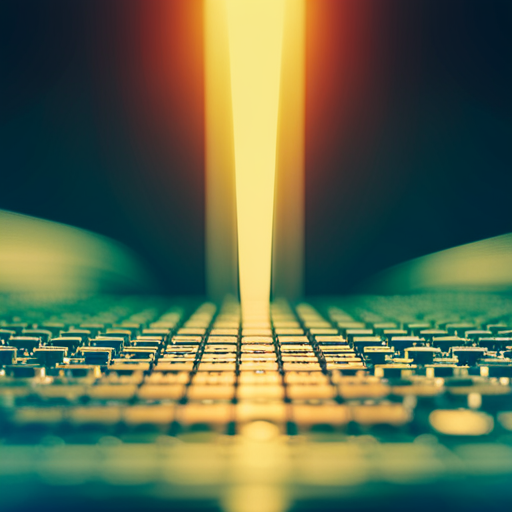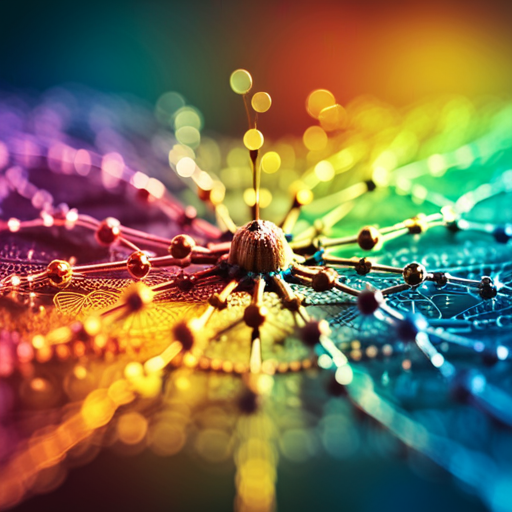Are you curious about autoencoders? Look no further!
This comprehensive guide will demystify the inner workings of autoencoders and provide you with a clear understanding.
You’ll explore different types of autoencoders, learn how they work, and discover their wide range of applications.
We’ll also delve into training and tuning techniques to optimize their performance.
Get ready to dive into the world of autoencoders and stay ahead of the curve with future trends in this exciting field!
Key Takeaways
– Autoencoders are neural networks used for encoding and decoding data efficiently.
– They compress high-dimensional input data into a lower-dimensional latent space, capturing essential features.
– Autoencoders have applications in data compression, denoising, and data generation.
– They can be used for image reconstruction, anomaly detection, dimensionality reduction, and generative modeling.
What Are Autoencoders?
@ Midjourney AI Image Prompt: /imagine prompt:Create an image showcasing the inner workings of an autoencoder, with multiple layers of neurons connected by arrows representing the flow of information. Highlight the encoder and decoder sections to visually explain the concept. –v 5.2 –ar 16:9
Autoencoders are neural networks that can learn to encode and decode data. They are a powerful tool in the field of machine learning, allowing you to efficiently represent and reconstruct complex patterns in your data.
By training an autoencoder, you can compress high-dimensional input data into a lower-dimensional representation, known as the latent space. This latent space captures the essential features of your data, enabling you to perform various tasks such as data compression, denoising, and even generation of new data samples.
The autoencoder consists of two main components: an encoder and a decoder. The encoder takes the input data and compresses it into a lower-dimensional representation, reducing the dimensionality of the data. The decoder then takes this compressed representation and reconstructs the original input data. The goal of the autoencoder is to minimize the difference between the input data and the output data, ensuring accurate reconstruction.
Autoencoders have various applications in different domains. For example, in image processing, they can be used for tasks such as image denoising, inpainting, and even image generation. In natural language processing, autoencoders can be applied for tasks like text summarization, machine translation, and sentiment analysis.
Types of Autoencoders
@ Midjourney AI Image Prompt: /imagine prompt:Create an image showcasing the different types of autoencoders: vanilla, sparse, denoising, and variational. Use distinct visual elements to illustrate their unique architectures, such as sparsity masks, noise filters, and latent spaces. –v 5.2 –ar 16:9
Explore the various types of autoencoders to gain a deeper understanding of how they can be applied in different scenarios. Autoencoders come in different flavors, each with its own unique characteristics and use cases.
One type of autoencoder is the vanilla or standard autoencoder. It consists of an encoder network that compresses the input data into a latent representation and a decoder network that reconstructs the original input from the latent representation. This type of autoencoder is useful for dimensionality reduction and data compression tasks.
Another type is the sparse autoencoder, which adds a sparsity constraint to the vanilla autoencoder. This constraint encourages the encoder to learn sparse representations, where most of the neurons are inactive. Sparse autoencoders can be applied in scenarios where feature selection or anomaly detection is important.
Variational autoencoders (VAEs) are a popular type of autoencoder that introduces probabilistic modeling. VAEs aim to learn the underlying probability distribution of the input data, allowing for generating new samples. They are commonly used in generative modeling tasks like image generation.
Lastly, there are denoising autoencoders that are trained to reconstruct clean data from noisy inputs. These autoencoders can be useful in scenarios where the data is corrupted or contains missing information.
Working Principles of Autoencoders
@ Midjourney AI Image Prompt: /imagine prompt:Create an image showcasing the intricate layers of an autoencoder, with encoder and decoder components clearly visible. Use vibrant colors to illustrate the data compression and reconstruction process, emphasizing the working principles of autoencoders. –v 5.2 –ar 16:9
In this discussion, you will explore the working principles of autoencoders. You will focus on the key points of encoder-decoder architecture and dimensionality reduction techniques.
You will learn how the encoder and decoder components work together to compress and reconstruct data. Additionally, you will understand how dimensionality reduction is achieved through feature extraction.
Understanding these principles will provide you with a solid foundation for effectively utilizing autoencoders in various applications.
Encoder-Decoder Architecture
The encoder-decoder architecture allows you to transform your input data into a compressed representation and then reconstruct it back to its original form. This architecture consists of two main components: the encoder and the decoder.
The encoder takes the input data and reduces its dimensionality, capturing the most important features. It uses techniques like convolutional or recurrent neural networks to capture the underlying patterns. The encoder produces a compressed representation, also known as a latent space or bottleneck, which contains the most important features of the input data.
The decoder takes the compressed representation and applies the reverse transformations to reconstruct the original data. It uses techniques like deconvolutional or recurrent neural networks to upsample the compressed representation. The decoder outputs the reconstructed data, which should ideally be as close as possible to the original input.
Dimensionality Reduction Techniques
One common technique for dimensionality reduction is Principal Component Analysis (PCA). PCA finds the directions of greatest variance in the data and projects it onto a lower-dimensional subspace.
So, how does PCA work and why is it useful? Well, imagine you have a large dataset with many features. It can be overwhelming to work with such high-dimensional data, right?
PCA comes to the rescue by identifying the most important directions along which your data varies the most. By reducing the dimensionality of your data, you can simplify it and make it easier to analyze.
PCA achieves this by creating new variables, called principal components, that are a linear combination of the original features. These components capture the most important information in the data, allowing you to effectively reduce its complexity while retaining its essential characteristics.
Applications of Autoencoders
@ Midjourney AI Image Prompt: /imagine prompt:Create an image depicting a diverse range of real-world applications of autoencoders, such as image and video reconstruction, anomaly detection, dimensionality reduction, and generative modeling. –v 5.2 –ar 16:9
When it comes to discussing the applications of autoencoders, two key points to consider are image reconstruction accuracy and anomaly detection capabilities.
Autoencoders are known for their ability to reconstruct images with high accuracy, making them a valuable tool in computer vision tasks.
Additionally, autoencoders can also be used for anomaly detection, allowing you to identify and flag any unusual or abnormal patterns in your data.
Image Reconstruction Accuracy
To improve your understanding of autoencoders, focus on how accurately you can reconstruct images. Image reconstruction accuracy is one of the key metrics to assess the performance of autoencoders.
The goal of an autoencoder is to encode the input data into a lower-dimensional representation and then decode it back to its original form. By comparing the reconstructed image with the original image, you can determine how well the autoencoder is able to capture the important features of the input.
A high reconstruction accuracy indicates that the autoencoder is effectively learning and preserving the relevant information. However, if the reconstruction is poor, it suggests that the autoencoder is not able to capture the important details of the input data.
Anomaly Detection Capabilities
To enhance your understanding of autoencoders, focus on their ability to detect anomalies in data. Autoencoders are powerful tools that can uncover irregularities or outliers in datasets. By learning to reconstruct the input data, autoencoders can identify patterns that deviate significantly from the norm.
Here are three key aspects of autoencoders’ anomaly detection capabilities:
1. Unsupervised learning: Autoencoders don’t require labeled data to identify anomalies. They can learn from unlabelled datasets, making them highly versatile and applicable to various domains.
2. Dimensionality reduction: Autoencoders compress the input data into a lower-dimensional representation. Anomalies often exhibit noticeable deviations in this reduced space, making them easier to detect.
3. Reconstruction loss: Autoencoders measure the difference between the original and reconstructed data using a loss function. Anomalies tend to have higher reconstruction errors, acting as a signal for their presence.
Training and Tuning Autoencoders
@ Midjourney AI Image Prompt: /imagine prompt:Create an image showcasing the intricate process of training and tuning autoencoders. Depict a network diagram with layers of neurons, visualizing the flow of information and the iterative nature of optimization algorithms. –v 5.2 –ar 16:9
You should focus on training and tuning your autoencoders to ensure optimal performance.
Training an autoencoder involves feeding it with a large dataset and adjusting its parameters to minimize the difference between the input and the output. This process allows the autoencoder to learn the underlying patterns and structures in the data, enabling it to generate accurate reconstructions.
Tuning the autoencoder involves fine-tuning its architecture and hyperparameters to achieve the best results.
To train your autoencoder effectively, you should consider using a powerful training algorithm, such as backpropagation, which adjusts the weights and biases of the network to minimize the reconstruction error. Additionally, it’s important to choose an appropriate loss function that captures the similarity between the input and output. Regularization techniques, like dropout or L2 regularization, can also be applied to prevent overfitting and improve generalization.
When it comes to tuning your autoencoder, experimenting with different architectures can lead to better results. You can vary the number of layers, the number of neurons in each layer, or even try using different activation functions. It’s also important to find the right balance between the size of the bottleneck layer and the capacity of the network. Regularizing the autoencoder by adding noise to the input or using denoising autoencoders can also enhance its performance.
Future Trends in Autoencoder Research
@ Midjourney AI Image Prompt: /imagine prompt:Create an image depicting an intricate neural network structure with multiple layers, showcasing the interconnection of encoder and decoder components. Use vibrant colors to highlight the promising direction of future autoencoder research. –v 5.2 –ar 16:9
Now that you’ve learned about training and tuning autoencoders, let’s explore the future trends in autoencoder research. Staying up-to-date with the latest advancements in this field can give you a competitive edge. Here are four areas that researchers are currently exploring:
1. Improved architecture design: Researchers are continuously experimenting with new architectures to enhance the performance of autoencoders. Variations such as convolutional autoencoders and recurrent autoencoders are being explored to tackle specific problems like image and sequence data.
2. Unsupervised learning: Autoencoders are primarily used for unsupervised learning tasks, but researchers are pushing the boundaries to make them more powerful. By incorporating techniques like adversarial training or reinforcement learning, autoencoders can learn from unlabelled data in a more effective and efficient manner.
3. Transfer learning: Transfer learning, where knowledge gained from one task is applied to another, is gaining attention in the autoencoder research community. By pretraining an autoencoder on a large dataset and then fine-tuning it on a smaller dataset, researchers aim to improve the model’s generalization capabilities.
4. Interpretability and explainability: Autoencoders are often considered as black boxes due to their complex internal representations. Researchers are working on techniques to make these models more interpretable and provide explanations for their predictions, making them more trustworthy and understandable.
Frequently Asked Questions
Can Autoencoders Be Used for Natural Language Processing Tasks?
Yes, autoencoders can be used for natural language processing tasks. They are neural networks that can learn to compress and reconstruct text, making them suitable for tasks like text generation and sentiment analysis.
How Do Autoencoders Compare to Other Unsupervised Learning Algorithms?
Autoencoders compare to other unsupervised learning algorithms by learning to encode and decode data, allowing for dimensionality reduction and reconstruction. They can be used for various tasks, including anomaly detection and generative modeling.
Are There Any Limitations or Drawbacks to Using Autoencoders?
Yes, there are limitations to using autoencoders. They may not perform well with complex data, require large amounts of training data, and can be computationally expensive.
Can Autoencoders Be Used for Real-Time Anomaly Detection?
Yes, autoencoders can be used for real-time anomaly detection. They have the ability to learn normal patterns and identify deviations from them, allowing for quick detection of anomalies as they occur.
What Are Some Potential Challenges in Training and Fine-Tuning Autoencoders for Complex Datasets?
Some potential challenges in training and fine-tuning autoencoders for complex datasets include finding the optimal architecture, dealing with overfitting, and selecting appropriate hyperparameters. It’s important to carefully address these challenges to achieve good results.
Conclusion
In conclusion, autoencoders are powerful neural network models that can learn efficient representations of data by reconstructing the input themselves. They have various types, including denoising, sparse, and variational autoencoders, each with its own unique characteristics and applications.
Understanding the working principles of autoencoders is crucial for effectively training and tuning them.
As the field of deep learning continues to evolve, autoencoders are expected to play a vital role in various domains, such as image and speech recognition, anomaly detection, and data compression.



